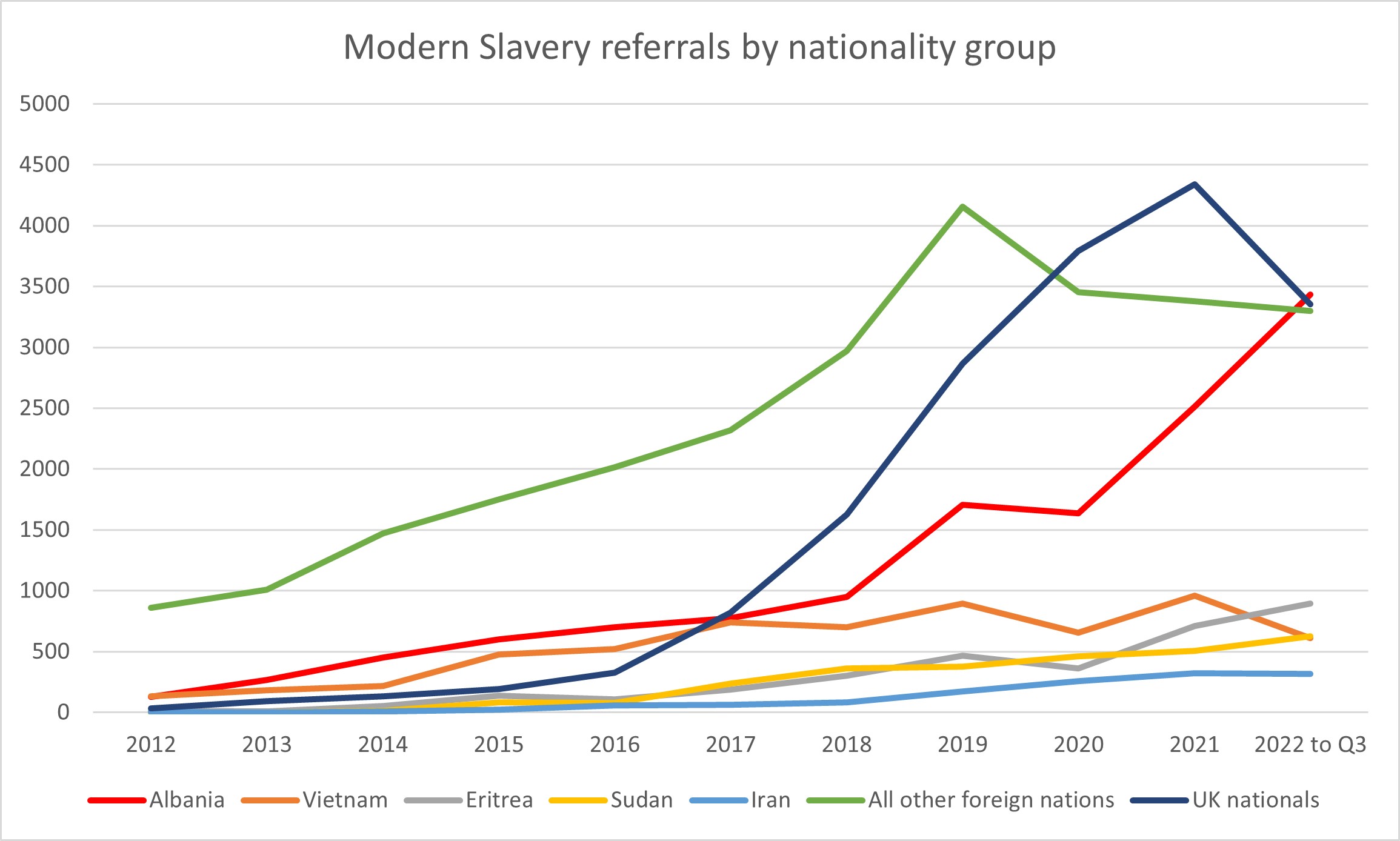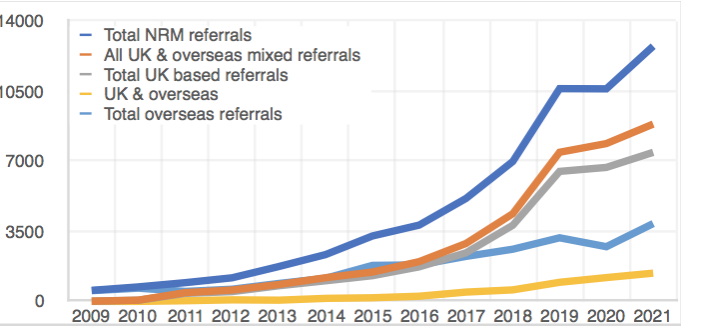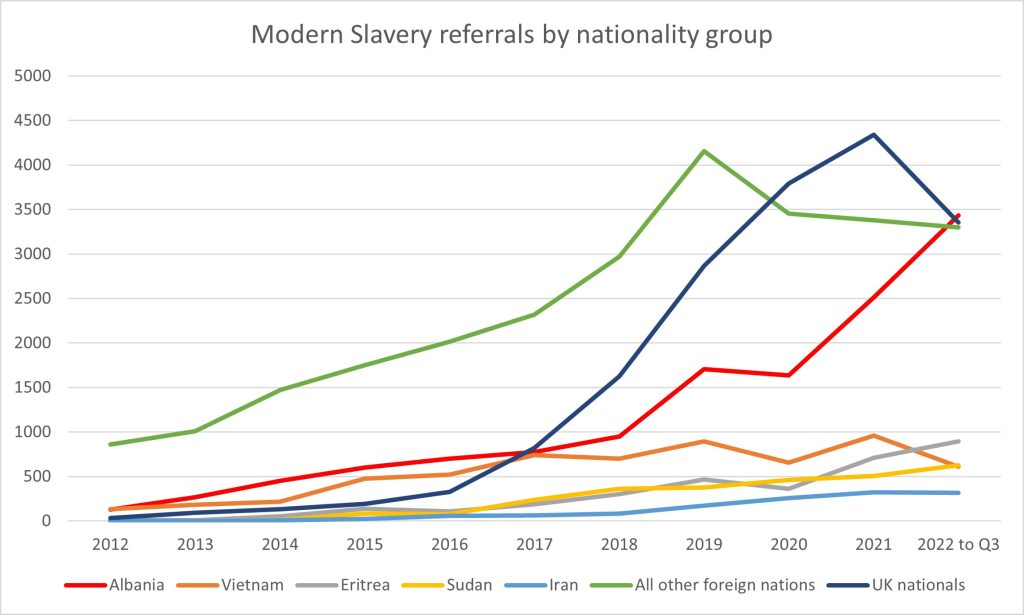
Key points
- According to a former immigration minister and sources within government, the Modern Slavery Act 2015 is being abused by migrants making the channel crossings with little if any proof. In some cases, immigrants are initially denying being modern slaves and changing their story later.
- Modern slavery claimants have increased from 552 in 2009 to 12,727 in 2021 while the number of foreign nationals making slavery claims has grown from 2,209 in 2014 to 8,388 in 2021.
- Claimants being referred for exploitation within the UK have grown from 2.5 per cent in 2009 to 58 per cent in 2021.
- Albanians have consistently been the largest foreign national group claiming exploitation and have grown in numbers by 1,862 per cent since 2012 and 165 per cent since 2018. Since 2021 there have been more Albanian referrals than the next four largest non-UK groups combined.
- For the first time in 2022, total Albanian referrals have overtaken referrals of British nationals.
1. The Modern Slavery Act 2015 was passed in order to combat modern slavery in the United Kingdom. Since 2018, 15,977 UK nationals (3,195 per year on average) have been referred to the National Referral Mechanism (NRM) under modern slavery laws and given support where appropriate. In addition to those UK nationals, 37,526 foreign nationals (an average of 7,505 per year) in the same period have made similar claims, some claiming to have been victims of modern slavery here in the UK and some abroad.
Number of NRM referrals
2. In the six years from 2009 to 2014, 7,470 potential victims of modern slavery (1,245 per year on average) were referred to the NRM. Meanwhile, in the seven years that followed (2015 to 2021) that number increased 611 per cent to 53,125 (7,589 per year on average).
3. Since 2018, (the first year for which data by nationality is available) the number of UK nationals being referred has increased by 172 per cent. While growth among overseas nationals stands at 129 per cent over the period; in total, overseas nationals outnumber UK nationals by a factor of 3-1 in referrals.
Referrals by location of exploitation 2009-2021
4. Data on the location of exploitation among referrals makes clear that the majority of those claiming to have suffered slavery claim that slavery to be UK-based. This marks a significant change from 2009 figures.
- Referrals claiming overseas exploitation have gone from 97 per cent of the total in 2009, to 30 per cent in 2021 despite increasing by 622 per cent in the same time frame.
- In 2009, there were no NRM referrals claiming joint exploitation within both the UK and overseas, although 1,410 made this claim in 2021, an increase of 40 times above the 2011 figure of 35.
- Referrals claiming exploitation within the UK have in contrast gone from only 2.5 per cent of all cases in 2009 to 58 per cent last year. This represents an increase of 53,000 per cent, or 531 times, in little more than a decade.

Referrals by nationality of claimant 2014-2022
- Of the five foreign nationalities to make up the largest groups of foreign NRM referrals in 2021, three feature high on the Global Slavery Index (Eritrea – 2nd place, Iran – 10th, Sudan – 14th), while Vietnam and Albania rank far lower at 77th and 43rd respectively. Rankings on the index are decided by the estimated prevalence of slaves per 1,000 people.
- From 2012 to 2017 Albanian and Vietnamese claimants remained within a narrow numerical range that never exceeded a difference of 233. Yet in 2018, the year the Channel crossings began in earnest, the number of Albanian claimants started significantly to outstrip Vietnamese claimants (who have consistently been in the top three claimant nationalities since at least 2014, excluding the UK). Since that point, the number of Albanian claimants has increased by 165 per cent.
- Since 2012, the number of Albanian claimants has increased by 1,862 per cent.
- In the first three quarters of 2022, for the first time since 2017, the number of Albanian NRM referrals overtook those of UK nationals and was approximately equal to all other foreign nationalities excluding the other four highest groups.

6. While current data do not allow for a direct connection to be made between NRM referrals and illegal channel crossings, in 2021 a total of 2,498 claimants were referred to the NRM by UK Visas and Immigration and Border Force (UKVI and Border Force have, amongst other duties, responsibility for processing illegal entrants at Dover).
7. One recent newspaper report, for example, cited government sources who said Albanian asylum seekers were exploiting modern slavery laws after crossing the Channel. If true, it is possible that of the 2,511 Albanians referred to the NRM in 2021, almost all of them could have been referred by UKVI staff at Dover after making an illegal Channel crossing.
8. According to former immigration minister Chris Philp, the threshold of proof for a successful claim has been progressively lowered as a result of campaigning by NGOs and migrant rights’ groups and activist lawyers. The position now is one of an initial denial of being a victim of modern slavery being disregarded should an illegal entrant subsequently change his or her mind and claim to be the victim of modern slavery.
